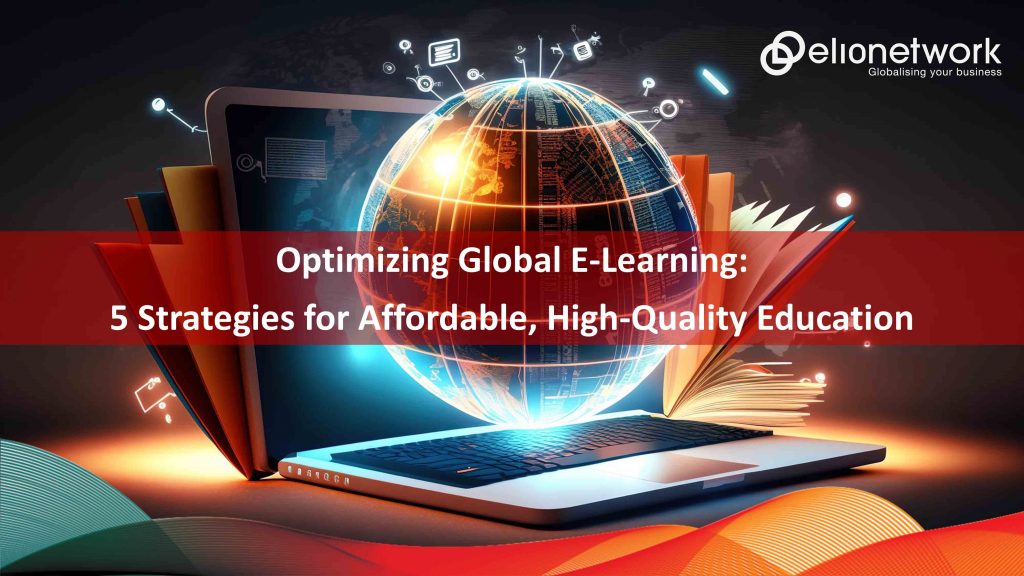Global E-Learning and Its Cost-Effective Evolution
In today’s ever-evolving educational landscape, global e-learning stands as a cornerstone of education for individuals of all ages. It is imperative to make global e-learning more cost-effective while maintaining quality and accessibility. In this post, we’ll delve into the significance of global e-learning, explore the associated challenges and opportunities, and outline five strategies to achieve cost-effectiveness.

Strategy 1: Embrace Scalable and Flexible Online Platforms and Tools
When striving for affordability, consider adopting scalable digital platforms. These digital solutions, exemplified by platforms like Coursera, Moodle, and Google Classroom, serve as the bedrock of modern education. They enable institutions and educators to transcend geographical constraints, providing learners with the freedom to explore at their own pace.
These platforms empower learners to guide their own journeys while offering features like self-paced modules, gamification, adaptive techniques, and peer feedback. This blend of flexibility and innovation enhances engagement, increases retention, and improves satisfaction—critical factors in building a sustainable digital education model. As the learning landscape continues to evolve, this remains a powerful driver of accessible, high-quality education.

Strategy 2: Prioritise a Learner-Centered Design Approach
Placing the learner at the heart of content design is essential for cost-effective outcomes. This strategy places the learner’s needs at the forefront of educational content creation. It involves meticulous learner analysis, the definition of clear learning objectives, careful selection of instructional strategies, and rigorous evaluation of learning outcomes. Additionally, it emphasises the importance of translation and localisation, ensuring that global e-learning content aligns with diverse cultural contexts, linguistic nuances, and technical requirements. This approach assures that learners experience education that is not only effective but also culturally relevant and linguistically precise.

Strategy 3: Harness Existing Resources and Open Educational Resources (OERs)
Harnessing existing resources and Open Educational Resources (OERs) presents an ingenious way to make global e-learning cost-effective. This strategy capitalises on a wealth of readily available materials, like those offered by platforms such as Khan Academy, TED-Ed, and Wikipedia.
By doing so, organisations reduce development costs while maintaining alignment with learning objectives and content standards. The key lies in ensuring the chosen materials are relevant, up-to-date, and pedagogically sound.

Strategy 4: Implement Cost-Efficient Approaches to Boost Learning Outcomes
Implementing cost-efficient approaches to enhance learning outcomes is a key facet of cost-effective global e-learning. Drawing from insights provided by the Global Education Evidence Advisory Panel, these approaches involve strategies such as providing constructive feedback, offering remedial teaching, structuring pedagogy, and incorporating early childhood development interventions.
These methods have proven to be impressively cost-effective, especially across low- and middle-income regions. By putting them into practice, institutions can boost the return on investment in digital education efforts, making learning not only more accessible but also genuinely impactful.

Strategy 5: Foster Global Collaboration with Partners and Stakeholders
Fostering collaboration across borders is essential to make education truly inclusive and effective. Governments, non-governmental organisations, universities, corporations, and even the learners themselves, all join forces to shape the future of e-learning. This collaborative synergy harnesses a wealth of expertise, fosters the exchange of best practices, addresses specific educational needs, and collectively dismantles barriers. In doing so, a vast network of stakeholders enriches the quality and impact of dynamic educational network, transcending borders and unifying diverse perspectives. The result is an educational landscape that remains universally accessible, culturally relevant, and responsive to the ever-evolving global educational landscape.

Closing Remarks: Shaping the Future of Global E-Learning
In conclusion, global e-learning is a transformative force, granting universal access to knowledge. Cost-effectiveness is crucial to ensure inclusivity. With the invaluable support of language service providers like elionetwork, spanning over two decades, serving global clientele, and a strong Asian presence, we ensure language consistency and impactful global reach. elionetwork assists in creating a cohesive global brand image and language presence, allowing your team to focus on core competencies. elionetwork enriches the global educational landscape by making e-learning accessible and culturally relevant. Your thoughts and ideas are welcome as we shape the future of education together. Join us in this endeavor by sharing your feedback or suggestions.


